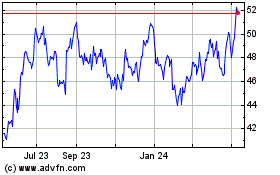To land next leadership role, ousted executives need to control
how others perceive the forced departure
By Joann S. Lublin
This article is being republished as part of our daily
reproduction of WSJ.com articles that also appeared in the U.S.
print edition of The Wall Street Journal (April 12, 2018).
Getting bounced from a high-powered job can be painful -- and
permanent. But in today's tight labor market, some top managers are
finding ways to rebound.
Executives who make successful comebacks often restore their
professional credibility by taking charge of their story and
changing how others view their forced departure, leadership
specialists and executive recruiters say.
Last month saw two major executive comebacks. Jim Donald, ousted
from Starbucks Corp. a decade ago, became president and chief
operating officer of Albertsons Cos., a grocery chain in 35 states
and Washington, D.C. When Starbucks asked him to step down from his
chief executive perch in 2008, the coffee company's share price was
depressed amid worries that the chain had over-expanded.
Albertsons's announcement March 5 that Mr. Donald was taking its
second-highest job said he led Starbucks through a time of "strong
growth." Mr. Donald declined to comment.
In late March, Deborah Wahl joined General Motors Co. as chief
marketing officer for its Cadillac brand. She left a similar role
at McDonald's Corp. last year as part of a management shake-up
aimed at reviving the burger chain's fortunes.
Ms. Wahl told Cadillac that she helped transform McDonald's
during her three-year stint and her exit was a mutual decision, a
person familiar with her situation recalled.
An assessment of 155 executives by G.H. Smart & Co., a
leadership advisory firm, found that nearly 25% of the executives
had been dismissed at least once. And of those, 70% found a fresh
job within nine months -- usually at the same level or higher.
People who rebound tend to own their mistakes rather than
blaming others and they learn from them, says Elena Lytkina
Botelho, a G.H. Smart partner and co-author of "The CEO Next
Door."
"Executives who saw their mistakes as failures were less
successful in their next job," Ms. Botelho added.
Pervasive social media can keep messy exits in the spotlight and
delay leaders from moving on.
"The permanence of our mistakes when recorded online can take us
down instantly -- or certainly make it a lot harder to overcome a
loss of credibility," says Joelle K. Jay, an executive coach and
co-author of "The New Advantage," a book for women leaders.
Gail Kelman, a senior manager counseled by Dr. Jay, said she
struggled to explain to potential employers why MetLife Inc.
eliminated her position in late 2012. She had worked there 15 years
and advanced to handling leadership development for its U.S.
staffers.
Getting laid off for the first time felt "very much like a
failure," Ms. Kelman says. "So much of my worth was tied up in my
role."
Dr. Jay encouraged her to craft and practice a brief description
linking her layoff to MetLife's revamped strategic direction and
insurance-industry shifts. Repeated rehearsals allowed Ms. Kelman
to move past anger and tears in order to pitch herself
effectively.
In early 2013, she joined Guardian Life Insurance Co. of America
as a midlevel manager and two years later, won an executive role
for the first time. Ms. Kelman now heads learning and career
development for the insurer.
Other executives regain credibility by confidently discussing
how their setback has made them better bosses. "It's how you
recover from a job loss that really builds your character," said
William Amelio, chief executive of Avnet Inc., an electronics
distributor.
Mr. Amelio was an Avnet board member when fellow directors
considered making him interim CEO in 2016. Mr. Amelio shared with
them the lessons he learned after he was terminated without cause
the previous year as chief of CHC Group Ltd., an oil-field services
firm.
Mr. Amelio joined CHC in 2010, about 18 months after being
ousted as leader of Chinese computer maker Lenovo Group Ltd., which
had been dealing with a sharp downturn. While at Lenovo, he cut
costs by $1 billion, fixed the company's supply chain and adopted a
strategy that helped it operate for a long time, he said.
"I was too eager to get back into the CEO seat," Mr. Amelio
recalled telling the rest of Avnet's board. In hindsight, he said,
"I should have been more selective on my next job."
In taking the CHC CEO job, Mr. Amelio overlooked the
insurmountable challenge of commanding a capital-intensive business
burdened by high debt and falling demand during an energy industry
downturn.
Mr. Amelio ran CHC for five years until a new investor decided
to bring in a fresh management team. CHC filed for bankruptcy
protection in 2016, the year after Mr. Amelio left.
Avnet directors gave him their vote of confidence as interim CEO
that July and then made him its permanent leader two months
later.
Write to Joann S. Lublin at joannlublin@gmail.com
(END) Dow Jones Newswires
April 12, 2018 02:47 ET (06:47 GMT)
Copyright (c) 2018 Dow Jones & Company, Inc.
Avnet (NASDAQ:AVT)
Historical Stock Chart
From Mar 2024 to Apr 2024

Avnet (NASDAQ:AVT)
Historical Stock Chart
From Apr 2023 to Apr 2024
